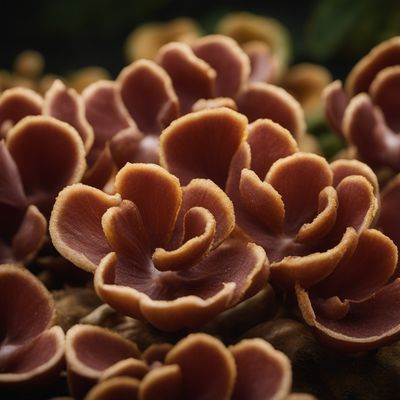
Ingredient
Horse mushrooms
The Majestic Fungi of the Earth
Horse mushrooms are one of the largest edible mushrooms, known for their creamy white caps and thick, fleshy stems. They have a mild and earthy flavor, similar to button mushrooms, but with a more pronounced umami taste. Their texture is firm and meaty, making them suitable for grilling, roasting, or sautéing.
Origins and history
Horse mushrooms have a long history of culinary use, particularly in European cuisines. They have been enjoyed for centuries in dishes ranging from soups and stews to risottos and pasta sauces. Horse mushrooms are also highly regarded for their nutritional value and medicinal properties.
Nutritional information
Horse mushrooms are low in calories and fat, while being a good source of protein, fiber, and various vitamins and minerals. They are particularly rich in potassium, phosphorus, and selenium. However, it's important to note that some individuals may be allergic to mushrooms, so caution should be exercised when consuming horse mushrooms.
Allergens
Horse mushrooms may cause allergic reactions in individuals who are sensitive to mushrooms or have mushroom allergies. It is advisable to consult a healthcare professional if you have any concerns or known allergies.
How to select
When selecting horse mushrooms, look for specimens that have firm, unblemished caps and stems. Avoid mushrooms that are slimy, discolored, or have a strong odor. Horse mushrooms should have a clean, earthy scent. It's also important to note that wild mushrooms should only be foraged by experienced individuals, as some species can be toxic.
Storage recommendations
To maintain the freshness and quality of horse mushrooms, store them in a paper bag or a loosely closed container in the refrigerator. Avoid storing them in plastic bags, as this can cause moisture buildup and spoilage. Use them within a few days for the best flavor and texture.
How to produce
Horse mushrooms can be cultivated at home using mushroom-growing kits or by inoculating suitable substrates with mushroom spawn. They require specific growing conditions, including a cool and humid environment. Alternatively, horse mushrooms can be purchased from specialty food stores or farmers markets.
Preparation tips
Horse mushrooms can be prepared in various ways, such as grilling, roasting, sautéing, or stuffing. They can also be used in soups, stews, risottos, and pasta dishes to add a meaty texture and umami flavor. Additionally, horse mushrooms can be marinated or pickled for a unique twist.
Culinary uses
Horse mushrooms are commonly used in European cuisines, particularly in dishes from the United Kingdom, France, and Italy. They are often featured in hearty dishes like mushroom risotto, mushroom soup, and stuffed mushrooms.
Availability
Horse mushrooms are commonly available in temperate regions around the world, including Europe, North America, and parts of Asia. They can be found in specialty food stores, farmers markets, or foraged in the wild.
More ingredients from this category » Browse all

Pleurotus
The Versatile Oyster Mushroom

Corn smuts
The Mysterious Corn Fungus

Jew's ears
Nature's Edible Fungi: Unveiling the Secrets of Jew's Ears

Common mushrooms
The Versatile Fungi

Enokitake
The Delicate Beauty of Enokitake Mushrooms

Other cultivated fungi
Exquisite Edible Fungi

Pom-pom blancs
The Delicate Delight: Exploring the World of Pom-pom Blancs

Fusarium venenatum
The Fungal Protein: Fusarium Venenatum

Nameko
The Versatile Mushroom

Shimeji
The Delicate Mushroom: Shimeji

Wood blewits
The Enigmatic Wood Blewits: A Hidden Gem in the Culinary World

Snow mushrooms
The Delicate Beauties of the Forest